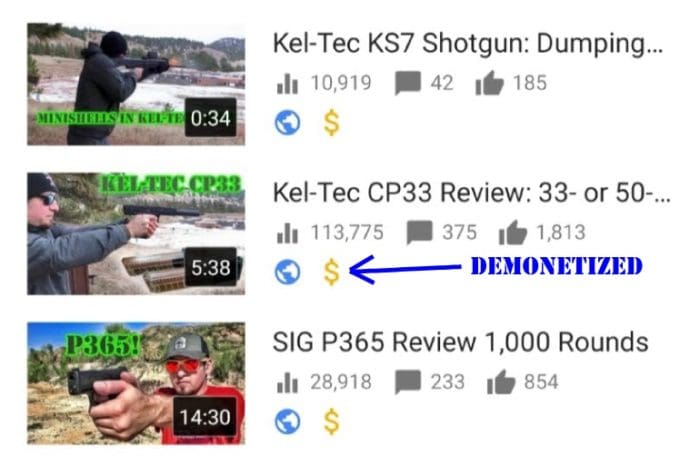Not exactly breaking news, right? But the percentage of my videos that YouTube chooses to pull paid advertising from just keeps going up. Click this photo (possibly twice) to expand it:
That’s my last 29 videos in order. Of those, 20 are demonetized and 1 was removed as “inappropriate content” (a no-frills suppressor review). That’s a 72.4 percent reject rate.
When a video is marked for limited ads, the above is what that means. For all of my videos, it has meant a full loss of any revenue.
YouTube’s “advertiser-friendly content guidelines” can be found HERE. Which one of the following categories would you say I’m in violation of?
Controversial issues and sensitive events
Video content that features or focuses on sensitive topics or events including, but not limited to, war, political conflicts, terrorism or extremism, death and tragedies, sexual abuse, even if graphic imagery is not shown, is generally not suitable for ads. For example, videos about recent tragedies, even if presented for news or documentary purposes, may not be suitable for advertising given the subject matter.
Drugs and dangerous products or substances
Video content that promotes or features the sale, use, or abuse of illegal drugs, regulated drugs or substances, or other dangerous products is not suitable for advertising. Videos discussing drugs or dangerous substances for educational, documentary, and artistic purposes are generally suitable for advertising, so long as drug use or substance abuse is not graphic or glorified.
Harmful or dangerous acts
Video content that promotes harmful or dangerous acts that result in serious physical, emotional, or psychological injury is not suitable for advertising. Some examples include videos depicting painful or invasive surgical or cosmetic procedures, or pranks involving sexual harassment or humiliation.
Hateful content
Video content that promotes discrimination or disparages or humiliates an individual or group of people on the basis of the individual’s or group’s race, ethnicity or ethnic origin, nationality, religion, disability, age, veteran status, sexual orientation, gender identity, or other characteristic that is associated with systemic discrimination or marginalization is not suitable for advertising. Content that is satire or comedy may be exempt; however, simply stating your comedic intent is not sufficient and that content may still not be suitable for advertising.
Inappropriate language
Video content that contains frequent uses of strong profanity or vulgarity throughout the video may not be suitable for advertising. Occasional use of profanity won’t necessarily result in your video being unsuitable for advertising, but context matters.
Inappropriate use of family entertainment characters
Videos depicting family entertainment characters or content, whether animated or live action, engaged in violent, sexual, vile, or otherwise inappropriate behavior, even if done for comedic or satirical purposes, are not suitable for advertising.
Incendiary and demeaning
Video content that is gratuitously incendiary, inflammatory, or demeaning may not be suitable for advertising. For example, video content that shames or insults an individual or group may not be suitable for advertising.
Sexually suggestive content
Video content that features highly sexualized content, such as video content where the focal point is nudity, body parts, or sexual simulations, is not suitable for advertising. Content that features sex toys, sexual devices, or explicit conversation about sex may also not be suitable for advertising, with limited exceptions for non-graphic sexual education videos.
Violence
Video content where the focal point is on blood, violence, or injury, when presented without additional context, is not suitable for advertising. Violence in the normal course of video gameplay is generally acceptable for advertising, but montages where gratuitous violence is the focal point is not. If you’re showing violent content in a news, educational, artistic, or documentary context, that additional context is important.
